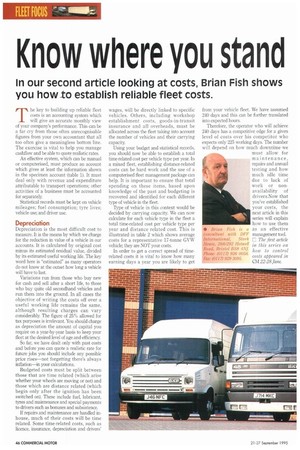Know where you stand
Page 48

If you've noticed an error in this article please click here to report it so we can fix it.
In our second article looking at costs, Brian Fish shows you how to establish reliable fleet costs.
The key to building up reliable fleet costs is an accounting system which will give an accurate monthly view of your company's performance. This can be a far cry from those often unrecognisable figures from your own accountant that all too often give a meaningless bottom line. The exercise is vital to help you manage cashflow and be able to quote realistic rates.
An effective system, which can be manual or computerised, must produce an account which gives at least the information shown in the specimen account (table 1). It must deal only with revenue and expenditure attributable to transport operations; other activities of a business must be accounted for separately Statistical records must be kept on vehicle mileages; fuel consumption; tyre lives; vehicle use; and driver use.
Depredation
Depreciation is the most difficult cost to measure. It is the means by which we charge for the reduction in value of a vehicle in our accounts. It is calculated by original cost minus its estimated residual value, divided by its estimated useful working life. The key word here is "estimated" as many operators do not know at the outset how long a vehicle will have to last.
Variations run from those who buy new for cash and sell after a short life, to those who buy quite old secondhand vehicles and run them into the ground. In all cases the objective of writing the costs off over a useful working life remains the same, although resulting charges can vary considerably The figure of 25% allowed for tax purposes is irrelevant. You should charge as depreciation the amount of capital you require on a year-by-year basis to keep your fleet at the desired level of age and efficiency.
So far, we have dealt only with past costs and before you can quote a realistic rate for future jobs you should include any possible price rises—not forgetting there's always inflation—in your calculations.
Budgeted costs must be split between those that are time related (which arise whether your wheels are moving or not) and those which are distance related (which begin only after the ignition has been switched on). These include fuel, lubricant. tyres and maintenance and special payments to drivers such as bonuses and subsistence.
If repairs and maintenance are handled inhouse, much of their costs will be time related. Some time-related costs, such as licence, insurance, depreciation and drivers' wages, will be directly linked to specific vehicles. Others, including workshop establishment costs, goods-in-transit insurance and all overheads, must be allocated across the fleet taking into account the number of vehicles and their carrying capacity.
Using your budget and statistical records, you should now be able to establish a total time-related cost per vehicle type per year. In a mixed fleet, establishing distance-related costs can be hard work and the use of a computerised fleet management package can help. It is important to ensure that total spending on these items, based upon knowledge of the past and budgeting is recovered and identified for each different type of vehicle in the fleet.
Type of vehicle in this context would be decided by carrying capacity. We can now calculate for each vehicle type in the fleet a total time-related cost per vehicle type per year and distance related cost. This is illustrated in table 2 which shows average costs for a representative 17-tonne GVW vehicle; they are NOT your costs.
In order to get a correct spread of timerelated costs it is vital to know how many earning days a year you are likely to get from your vehicle fleet. We have assumed 240 days and this can be further translated into expected hours.
Therefore, the operator who will achieve 240 days has a competitive edge for a given level of costs over his competitor who expects only 225 working days. The number will depend on how much downtime we must allow for maintenance, repairs and annual testing and how much idle time due to lack of work or nonavailability of drivers.Now that you've established your costs, the
Inext article in this series will explain how to use them as an effective management tool. E The first article in this series on how to control costs appeared in CM 2228 June. • Brian Fish is a consultant with DPP' International, Stork House, 288/292 Hotwell Road, Bristol BS8 4NJ, Phone: (011 926 0058. Fax: (0117) 929 3095.




































































































